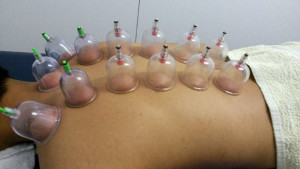
What is cupping?
Cupping is one of the oldest methods of traditional Chinese medicine. Originally, practitioners would use hollowed-out animal horns for cups, and place them over particular points or meridians. Today, most acupuncturists use cups made of thick glass or plastic, although bamboo, iron and pottery cups are still used in other countries. Glass cups are the preferred method of delivery, because they do not break as easily as pottery or deteriorate like bamboo, and they allow the acupuncturist to see the skin and evaluate the effects of treatment.
How does cupping work?
In a typical cupping session, glass cups are warmed using a cotton ball or other flammable substance, which is soaked in alcohol, let, then placed inside the cup. Burning a substance inside the cup removes all the oxygen, which creates a vacuum.
As the substance burns, the cup is turned upside-down so that the practitioner can place the cup over a specific area. The vacuum created by the lack of oxygen anchors the cup to the skin and pulls it upward on the inside of the glass as the air inside the jar cools. Drawing up the skin is believed to open up the skin’s pores, which helps to stimulate the flow of blood, balances and realigns the flow ofqi, breaks up obstructions, and creates an avenue for toxins to be drawn out of the body.
Depending on the condition being treated, the cups will be left in place from 5 to 10 minutes. Several cups may be placed on a patient’s body at the same time. Some practitioners will also apply small amounts of medicated oils or herbal oils to the skin just before the cupping procedure, which lets them move the cups up and down particular acupoints or meridians after they have been applied.
In China, cupping is used primarily to treat respiratory conditions such as bronchitis, asthma, and congestion; arthritis; gastrointestinal disorders; and certain types of pain. Some practitioners also use cupping to treat depression and reduce swelling. Fleshy sites on the body, such as the back and stomach (and, to a lesser extent, the arms and legs), are the preferred sites for treatment.
